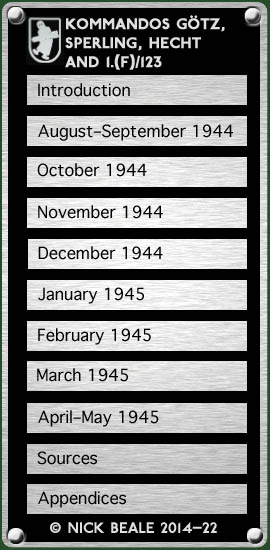|
Some Ar 234’s were based at Rheine up to the time he took off on his last flight on 1st March. [They] belonged to an experimental reconnaissance unit which was known under the cover name "Sperling”. Interrogation of Uffz. Erich Bock (3./JG 27) The Staffel’s first known operations for the month had been ordered by Luftwaffenkommando West on 28 February: A: the Humber Estuary B: SE England and harbours from Hull to Dover including Thames Estuary, D: P/R of V-weapon damage in Antwerp. From 08.04–10.27 hrs. on 2 March, Obltn. Radau, in 4U+BH carried out “A”, finding The Wash and the adjacent estuaries empty of all but small craft. Leutnant Viergutz (4U+IH) was up from 10.35–11.43 hrs. to fulfil “B” but aborted owing to a damaged engine. Oberfeldwebel Jorek was aloft from 12.15-13.55 hrs. in 4U+CH but could not carry out “D” because of bad weather which closed down 1.(F)/123’s flying for the rest of the day. The Staffel’s strength late that afternoon was 14 (12 crews) with aircraft B, C, E and G serviceable while A, F and I were out of commission. On the 5th, Luftflotte Reich announced that henceforth 1.(F)/33 at Wittmundhafen would take over the reconnaissance of the harbours, convoy routes and ground organisation of south eastern England as far south as (and including) London. The upshot of this was that “all special tasks concerning recce of England for (1.(F)/123” would lapse. With the Allied armies now closing up to the west bank of the Rhein, the Staffel’s missions were increasingly aimed at obtaining warning of where the inevitable crossing attempt would be made. In the event, the first crossing — by the Americans at Remagen on the 7th — was opportunistic and took the Germans by surprise. At 11.20 hrs. on the 9th, Ofw. Küppers took off, reportedly in 4U+BH, to cover the left bank of the river from Nijmegen to Köln (objectives assigned three days previously) but he had not returned by evening. (It is possible that Küppers’ machine was actually CH, since that aircraft disappears from the unit’s strength returns while BH is present, albeit unserviceable, the following day). Obertleutnant Krüper (4U+_H) was in the air for around 80 minutes from 14.46 but 10/10 cloud at 3500 m meant that no photo coverage could be obtained. Crew strength at 17.45 hrs. was 14 (13); Arados A, C and G were serviceable but E, F, I, M and H were not. It later transpired that 4U+BH had landed safely at Erfurt-Bindersleben. Next day’s bad weather precluded any operational flying by the Staffel and the next known mission was a visual reconnaissance of the area Koblenz – Weissenthurm – Winningen on the afternoon of 12 March. The following morning Obltn. Merk took 4U+MH up but landed again after only 24 minutes, having found the weather too bad for either visual or photographic observation. In addition, the unnamed pilot of 4U+HH attempted a special task on behalf of 14. Fliegerdivision but was thwarted by cloud cover along the Rhein between Emmerich and Köln; his flight lasted only from 10.18–10.50 hours. On the 14th, FAGr. 123 issued two sets of orders within ten minutes. The first, at 00.05 GMT, was thought by Bletchley Park to be for 1.(F)/100 as it assigned objectives in the southern half of the front: PR airfields in the Charleville – St. Quentin – Château Thierry – Chalons sur Marne area, and particularly of airfields in the vicinity of Rheims, to establish the whereabouts of enemy air transport units. Recce of roads in the Remagen – Bitburg – Trier – Koblenz area, to establish enemy forces being brought up towards the Rhein and Moselle. In the course of this, recce particularly of the Andernach – Mayen – Wittlich – Kochem – Koblenz area. P/R of the left-hand (D% Rhein bank) to a depth of (smudge) km. from Sinzig to Koblenz, to establish whether the enemy is making preparations here to cross. In fact, the second of these tasks was essayed by 1.(F)/123’s Obltn. Merk from 10.25–10.55 hrs. He got no results on account of the weather and although another attempt was made it had to be aborted when the Arado’s fuselage incurred damage on take-off.
The other set of objectives was: P/R of airfields in the area of Belgium and Holland, particularly in the Brussels area, to establish the whereabouts of enemy air transport units. Recce of Arnhem – Oss – Geldern – Hombergen area, and east of it as far as the Rhein, to ascertain preparations to cross. Permanent task: recce of V-effects at Antwerp with mosaic of the Kieldrecht – Achterbroek – Pulle – Boom area. Scale not smaller than 1:20.000. These do not seem to have been attempted at all and the Staffel’s orders for the 15th were a repeat of those for the 14th. Two Arados attempting to obtain photographic cover of Belgian and Dutch airfields both aborted with technical failures. Two were dispatched to the area Arnhem – east of Geldern – Homberg – and the Rhein but both were forced down and damaged after continual encounters with opposing fighters. Neither pilot was hurt however. It may be pertinent that HH was reported unserviceable the next day while AH does not appear again on the order of battle for over two weeks. continued on next page …
|
||||

